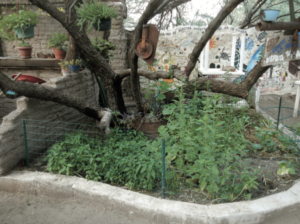[ad_1]
Whereas I used to be spending a month in Guatemala within the early Nineteen Nineties, I grew to become conscious of the truth that the idea of nurse plant guilds was well-known not solely within the Sonoran Desert the place I used to be from, however within the hotter tropical reaches of Central America as nicely. I had spent per week attempting to sleep within the sweltering warmth of a multistory concrete condominium in a crowded colonia of a Guatemalan metropolis earlier than getting access to a palm-thatched palapa hut in the course of a espresso plantation.
Though the 2 dwellings have been positioned lower than two miles aside and shared the identical macroclimate, the microclimate within the espresso plantation was a minimum of a dozen levels cooler by midday every day. The air-conditioning there was not constructed into the wall of the cone-shaped hut, however got here from the palm thatch of the roof, the espresso bushes across the hut, and the dense tree cover above us.
The Impression of Nurse Plant Guilds
The cultivated tree that supplied us such aid from the warmth is thought all through Latin America by the title madre de cacao, mom of cocoa. It’s a nitrogen-fixing legume identified to scientists as Gliricidia sepium. It might now be the woody tropical plant most generally used internationally to offer “shade for cacao, espresso, and different shade-loving crops.”
Though scientists have fostered the unfold of madre de cacao as a nurse plant for espresso to the numerous components of the Americas, the Caribbean, Africa, Asia, and the Pacific Islands, its first use as a buffer in opposition to warmth stress possible started within the Mayan-dominated reaches of Central America, the place madre de cacao was first recruited to offer shade for tender younger cacao crops. This will need to have occurred anciently, for madre de cacao is linked to each chocolate and arboreal monkeys within the historical Mayan epic the Popul Vuh.
As historians of the Mayan agricultural panorama have written, the cacao plant grew to become dependent upon madre de cacao bushes “as a result of it requires a fine-tuned ecosystem to outlive: it’s wind delicate, solar sensi- tive, drought delicate, and nitrogen dependent.” Had been it not for the tall, shade-producing, nitrogen-fixing windbreaks and nurse crops of madre de cacao and an in depth cacao relative (balam-té, protector tree), we would by no means have loved the pleasure of consuming chocolate or consuming sizzling cocoa.
Range of Nurse Vegetation

Mesquite features as a protecting nurse tree for herbs at Rancho el Peñasco Eco-Lodge in Sonora, Mexico.
Whereas I’ve been impressed by way of nurse bushes as a thermal buffer for heat-sensitive crops like espresso and cacao within the tropics of Central America, it seems that the range and significance of nurse crops is way extra putting within the deserts of North and South America. In truth, there are dozens of tree species nicknamed nodrizas or madrinas by desert dwellers, for they’re completely important to the germination and survival of a big portion of the edible flora rising in sizzling, dry climates.
Simply how a lot distinction can a nurse plant’s cover make in defending an understory herb or vegetable from devastating warmth and damaging photo voltaic radiation? Collaborating with my Mexican colleague and former pupil Humberto Suzán, we as soon as gathered a yr and a half ’s value of temperature data within the micro-environments beneath nurse bushes within the Sonoran Desert.
Learning Temperature to Cut back Warmth Stress
Earlier research—undertaken nicely earlier than local weather change was so evident—had instructed that the dense shade of a mature nurse tree might probably lower the utmost soil temperature beneath it by 20 ̊F (11 ̊C) levels on a summer time day, and lift the minimal temperature by 5 ̊F (3 ̊C) on a winter day. We determined to confirm these research by measuring the soil temperature each inside and past the understory of the desert ironwood tree, which has a dense evergreen cover that provides steady shade year-round.
In contrast with the 115.2 ̊F (46.2 ̊C) temperature of desert soil totally uncovered to the solar at midday, the soil temperature underneath the dense shade on the northern aspect of the ironwood cover was solely 95.8 ̊F (35.4 ̊C), nearly 20 ̊F levels cooler! Extra remarkably, the temperature of cactus stems underneath the identical ironwood was solely 94.8 ̊F (34.8 ̊C), inside the vary at which even pinto beans might develop and flower. The microclimate underneath close by mesquite bushes was almost as nicely buffered as these underneath ironwoods, with their temperatures hovering round 98.3 ̊F (36.8 ̊C) at midday in July.
[ad_2]


